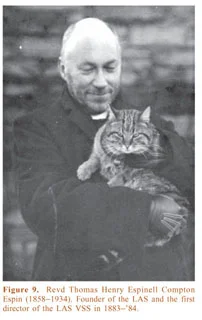One of the great difficulties of putting together a family memoir is to decide who to include and who to leave out. Immediate living members of the extended family cannot be ignored. But as one delves back into the past the task is more difficult and one is guided increasingly by their interest and relevance to us today.
Recently a cousin of Caroline mentioned a distant ancestor of theirs, the Rev Thomas Espin (1858-1934), who was a distinguished astronomer as well as being a parish priest. We were embarrassed to admit that we had no knowledge of him. Our subsequent researches revealed this great-great-uncle was a fascinating man. He is far too interesting and relevant to ignore.
The Espin crater on the Moon
Thomas Espin’s interest in astronomy was ignited by the appearance of Coggia’s Comet in 1874, a fantastic object with a magnificent tail. He became an avid amateur and skilled observer. He assisted the Rev Thomas Webb with the compilation of the famous book Celestial Objects for Common Telescopes and after Webb’s death he published expanded 5th and 6th editions.
He discovered many nebulas, variable stars and more than 2500 double stars. He made a large number of observations of the spectra of stars and in particular he did extensive searches for red stars and published a catalogue of them. He discovered Nova Lacertae in 1910 and a lunar crater was named after him – the Espin crater.
The Espin observatory at Close House, Heddon-on-the-Wall
Thomas Espin became a Fellow of the Royal Astronomical Society in 1878. He was awarded the Jackson-Gwilt Medal of the RAS in 1913.
His telescope, which is still one of the largest in England, together with the rest of his astronomical equipment, fell into disuse. David Sinden, chief optical engineer at Grubb Parsons, tracked the telescope down and found part of it being used as a pig trough. He restored it and it is now housed in the Espin Observatory, Close House, Heddon on the Wall. It belongs to Newcastle University and is used by students studying astronomy and astrophysics.
He was a man of prodigious energy. In addition to astronomy his scientific interests included botany, geology and the study of X-rays. He served as the Vicar of Tow Law until his death and was chair of Stanhope and Wolsingham Sessions. He never married.


